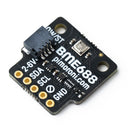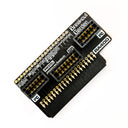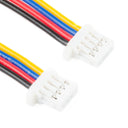BME688 4-in-1 Air Quality Breakout (Gas, Temperature, Pressure, Humidity)
by Pimoroni




The super-smart BME688 air quality sensor can measure temperature, pressure and humidity precisely. It also has an upgraded, AI-enhanced gas scanner!
Like its predecessor the BME680, this high quality sensor can be used to monitor every aspect of your environment, taking high precision measurements of temperature, pressure and humidity.
Additionally, the BME688 has an updated gas scanner function with extended measurements, which will react to changes in volatile organic compounds (VOCs), volatile sulfur compounds (VSCs) and the presence of carbon monoxide and hydrogen to give a general measure of indoor or outdoor air quality. With Bosch's software, you can analyse the gas readings further and train the algorithms to make inferences about specific air quality indicators, including the likelihood of bacteria growth and the presence of other organic contaminants.
Want to get an idea of whether there's adequate ventilation in your bedroom, your workshop, or workplace? Set up a BME688 on a Pi Zero W and have it log sensor readings to a file or post them into your home automation software or a web service like adafruit.io or freeboard.io.
This breakout is compatible with our fancy Breakout Garden system, where using breakouts is as easy just popping it into one of the slots and starting to grow your project, create, and code. It's also Qw/ST compatible so it can be plugged into a whole range of different microcontrollers and HATs with Qwiic or STEMMA QT connectors.
Features
- Bosch BME688 4-in-1 environmental sensor with Artificial Intelligence (datasheet)
- I2C interface, with address select via ADDR cuttable trace (0x76 or 0x77)
- Qwiic/STEMMA QT connector
- 3.3V or 5V compatible
- Reverse polarity protection (on Breakout Garden connector)
- Raspberry Pi-compatible pinout (pins 1, 3, 5, 7, 9)
- Compatible with Arduino
- Compatible with Raspberry Pi (Python library)
- Compatible with Raspberry Pi Pico (C++/MicroPython libraries)
-
C library provided by Bosch
- BME688 software
- Schematic
- Dimensional drawing
Kit includes
- BME688 breakout
- 1x5 male header
- 1x5 female right angle header
We've designed this breakout board so that you can solder on the piece of right angle female header and pop it straight onto the bottom left 5 pins on your Raspberry Pi's GPIO header (pins 1, 3, 5, 7, 9). The right angle header also has the advantage of positioning the breakout away from the Pi's CPU so as to minimise radiated heat.
Software
Bosch provide a C library,for this sensor, but we've also updated our BME680 Python library (with a quick and painless one-line-installer) to work with the BME688, making it straightforward to combine it with our other boards (why not use a Blinkt! or Unicorn pHAT to visualise air quality in real time?)
You can also use this breakout with Raspberry Pi Pico and other RP2040 boards, using C++ or Pirate brand MicroPython.
Notes
- In our testing, we've found that the sensor requires some burn-in time (at least 20 minutes) and that readings may take a couple of minutes to stabilise after beginning measurements
- The trace on the back of the board marked ADDR can be cut to change the I2C address from the default of 0x76 to 0x77, meaning that you can use up to two sensors on the same Raspberry Pi or Arduino
- The BME280, BME68X and BMP280 breakouts all share the same I2C addresses, so if you're using two together then you'll need to change the I2C address on one of them using the solder bridge or cuttable traces.
- Dimensions: approx 19mm x 19mm x 5mm (L x W x H, including connector)
-
BME688 4-in-1 Air Quality Breakout (Gas, Temperature, Pressure, Humidity)
PIM575Out of stock£15.75
Essentials
Other things that could come in handy!
-
Breakout Garden Mini (I2C)+ £9.00
-
 Breakout Garden for Raspberry Pi 400 & 500+ £9.00
Breakout Garden for Raspberry Pi 400 & 500+ £9.00 -
 4 Pin JST-SH Cable (Qwiic, STEMMA QT, Qw/ST) – JST-SH to JST-SH (200mm)+ £1.25
4 Pin JST-SH Cable (Qwiic, STEMMA QT, Qw/ST) – JST-SH to JST-SH (200mm)+ £1.25
Shop with confidence – we've been serving the hobbyist electronics, Maker, and retro gaming communities since 2012.
- Satisfaction or refund guarantee
- Worldwide shipping via mail or courier
- 57,000+ customer reviews
- Secure website and payments


